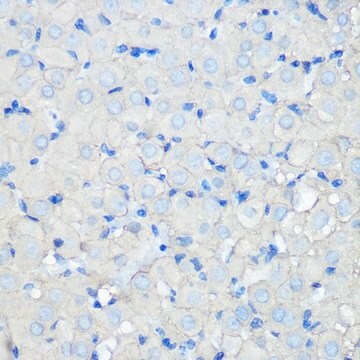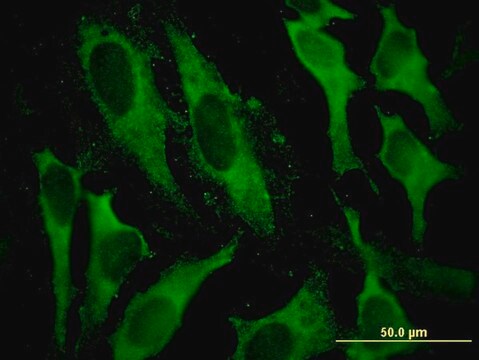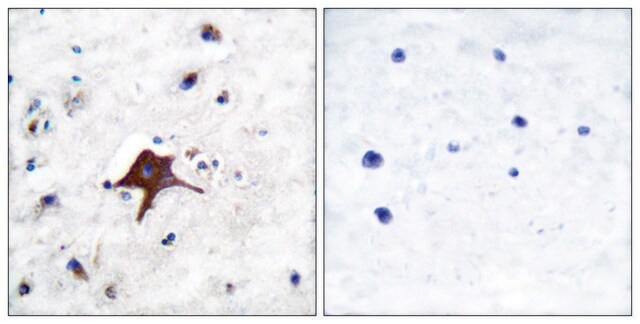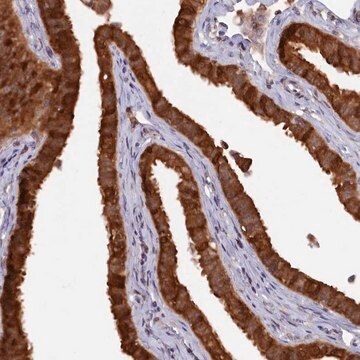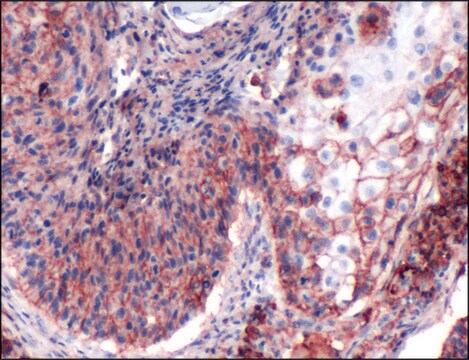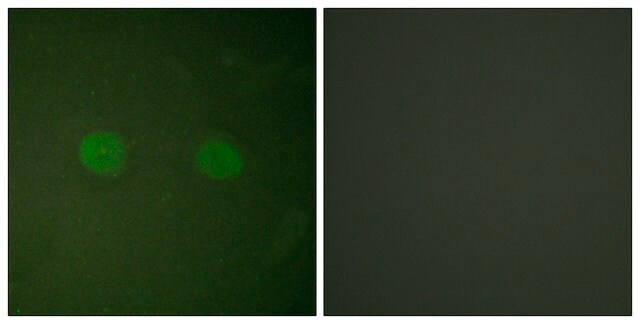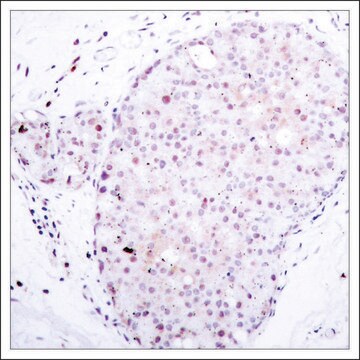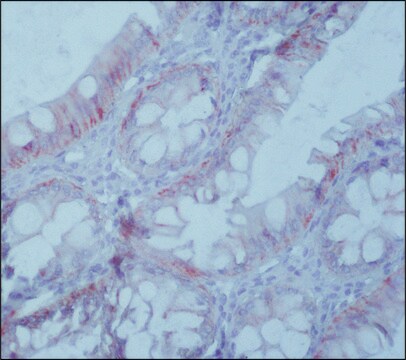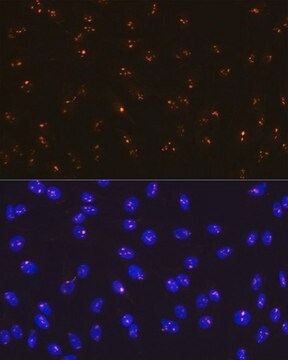MABS1283
Anti-MLN64/STARD3 Antibody, clone 2BE-2F4
ascites fluid, clone 2BE-2F4, from mouse
别名:
StAR-related lipid transfer protein 3, MLN64/STARD3, Metastatic lymph node gene 64 protein, MLN 64, Protein CAB1, START domain-containing protein 3, StARD3
登录查看公司和协议定价
所有图片(1)
About This Item
分類程式碼代碼:
12352203
eCl@ss:
32160702
NACRES:
NA.41
推荐产品
生物源
mouse
品質等級
抗體表格
ascites fluid
抗體產品種類
primary antibodies
無性繁殖
2BE-2F4, monoclonal
物種活性
human
技術
electron microscopy: suitable
immunocytochemistry: suitable
immunohistochemistry: suitable
western blot: suitable
同型
IgG1κ
NCBI登錄號
UniProt登錄號
運輸包裝
dry ice
目標翻譯後修改
unmodified
基因資訊
human ... STARD3(10948)
一般說明
MLN64/StARD3 (also known as es64, StAR-related lipid transfer protein 3, Metastatic lymph node gene 64 protein, Metastatic lymph node protein 64, StARD3, START domain-containing protein 3, Steroidogenic acute regulatory protein related; UniProt Q14849) is encoded by the MLN64 (or CAB1 & STARD3) gene in human (NCBI Gene ID 10948). MLN64/StARD3 is a late endosome (LE) multitransmembrane protein that plays an important role in intracellular cholesterol transport and steroidogenesis. In addition to binding cholesterol via its C-terminal STAR domain, MLN64/StARD3 is reported to interact with ER-anchored VAP proteins via a conserved motif called "two phenylalanines in an acidic tract" or FFAT, thereby forming an LE-ER tethering complex at the inter-organelle membrane contacts sites (MCSs), allowing heterologous membrane apposition and the exchange of metabolites (PMID 23709693 and 24105263). Clone 2BE-2F4 is also known as 2BE2F4 and mAbMLN64-Ct, it detects an epitope within the c-terminal region encompassing the last 20% of MLN64 sequence.
免疫原
Epitope: Near C-terminus
Ovalbumin-conjugated linear peptide corresponding to human MLN64/STARD3 near the C-terminus.
應用
Anti-MLN64/STARD3 Antibody, clone 2BE-2F4 is an antibody against MLN64/STARD3 for use in Western Blotting and Immunocytochemistry, Immunohistochemistry, Electron Microscopy.
Immunocytochemistry Analysis: A representative lot detected MLN64/STARD3 in MCF7/MLN64 cells (Alpy, F., et al. (2001). J. Biol. Chem. 276:4261-4269).
Immunocytochemistry Analysis: A representative lot detected MLN64/STARD3 in BT-474, MCF7, and transfected COS-1 cells (Lutz-Moog, C., et al. (1997). Int. J. Cancer. 71:183-191).
Immunohistochemistry Analysis: A representative lot detected MLN64/STARD3 in human breast tissue (Lutz-Moog, C., et al. (1997). Int. J. Cancer. 71:183-191).
Electron Microscopy Analysis: A representative lot detected MLN64/STARD3 in HeLa cells (Holtta-Vuori, M., et al. (2005). Molecular Biology of the Cell. 16:3873-3886).
Western Blotting Analysis: A representative lot detected MLN64/STARD3 in COS-1 cell lysate (Watari, H., et al. (1997). Proc. Natl. Acad. Sci. USA. 94:8462-8467).
Western Blotting Analysis: A representative lot detected MLN64/STARD3 in various human cell lines (Lutz-Moog, C., et al. (1997). Int. J. Cancer. 71:183-191).
Immunocytochemistry Analysis: A representative lot detected MLN64/STARD3 in BT-474, MCF7, and transfected COS-1 cells (Lutz-Moog, C., et al. (1997). Int. J. Cancer. 71:183-191).
Immunohistochemistry Analysis: A representative lot detected MLN64/STARD3 in human breast tissue (Lutz-Moog, C., et al. (1997). Int. J. Cancer. 71:183-191).
Electron Microscopy Analysis: A representative lot detected MLN64/STARD3 in HeLa cells (Holtta-Vuori, M., et al. (2005). Molecular Biology of the Cell. 16:3873-3886).
Western Blotting Analysis: A representative lot detected MLN64/STARD3 in COS-1 cell lysate (Watari, H., et al. (1997). Proc. Natl. Acad. Sci. USA. 94:8462-8467).
Western Blotting Analysis: A representative lot detected MLN64/STARD3 in various human cell lines (Lutz-Moog, C., et al. (1997). Int. J. Cancer. 71:183-191).
Research Category
Signaling
Signaling
Research Sub Category
Signaling Neuroscience
Signaling Neuroscience
品質
Evaluated by Western Blotting in SK-OV-3 cell lysate.
Western Blotting Analysis: A 1:2,000 dilution of this antibody detected MLN64/STARD3 in 10 µg of SK-OV-3 cell lysate.
Western Blotting Analysis: A 1:2,000 dilution of this antibody detected MLN64/STARD3 in 10 µg of SK-OV-3 cell lysate.
標靶描述
~50 kDa observed. This protein has isoforms at ~48 and ~49 kDa, which are covered by this antigen.
外觀
Unpurified
Mouse monoclonal IgG1κ ascites with 0.05% sodium azide.
儲存和穩定性
Stable for 1 year at -20°C from date of receipt.
Handling Recommendations: Upon receipt and prior to removing the cap, centrifuge the vial and gently mix the solution. Aliquot into microcentrifuge tubes and store at -20°C. Avoid repeated freeze/thaw cycles, which may damage IgG and affect product performance.
Handling Recommendations: Upon receipt and prior to removing the cap, centrifuge the vial and gently mix the solution. Aliquot into microcentrifuge tubes and store at -20°C. Avoid repeated freeze/thaw cycles, which may damage IgG and affect product performance.
其他說明
Concentration: Please refer to lot specific datasheet.
免責聲明
Unless otherwise stated in our catalog or other company documentation accompanying the product(s), our products are intended for research use only and are not to be used for any other purpose, which includes but is not limited to, unauthorized commercial uses, in vitro diagnostic uses, ex vivo or in vivo therapeutic uses or any type of consumption or application to humans or animals.
未找到合适的产品?
试试我们的产品选型工具.
儲存類別代碼
12 - Non Combustible Liquids
水污染物質分類(WGK)
nwg
閃點(°F)
Not applicable
閃點(°C)
Not applicable
MLN64 contains a domain with homology to the steroidogenic acute regulatory protein (StAR) that stimulates steroidogenesis.
Watari, H; Arakane, F; Moog-Lutz, C; Kallen, CB; Tomasetto, C; Gerton, GL; Rio, MC; Baker et al.
Proceedings of the National Academy of Sciences of the USA null
C Moog-Lutz et al.
International journal of cancer, 71(2), 183-191 (1997-04-10)
The MLN64 gene, which is localized in q12-q21 of the human chromosome 17, encodes a novel protein containing 2 distinct domains. At the N-terminal, MLN64 exhibits a potential trans-membrane region, while at the C-terminal, it shares homology with the F26F4.4
F Alpy et al.
The Journal of biological chemistry, 276(6), 4261-4269 (2000-10-29)
MLN64 is a transmembrane protein that shares homology with the cholesterol binding domain (START domain) of the steroidogenic acute regulatory protein. The steroidogenic acute regulatory protein is located in the inner membrane of mitochondria, where it facilitates cholesterol import into
MLN64 is involved in actin-mediated dynamics of late endocytic organelles.
Holtta-Vuori, M; Alpy, F; Tanhuanpaa, K; Jokitalo, E; Mutka, AL; Ikonen, E
Molecular Biology of the Cell null
我们的科学家团队拥有各种研究领域经验,包括生命科学、材料科学、化学合成、色谱、分析及许多其他领域.
联系技术服务部门